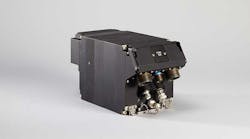Mobile User Objective System (MUOS) satellites represent a major shift in defense satellite communications, leveraging smartphone technology to provide secure communications. On that front, Rockwell Collins says its ARC-210 became the first airborne radio to operate on the MUOS satellite system. The ARC-210 contains both demand assigned multiple access (DAMA) and integrated waveform (IW). When combined with the MUOS waveform, the radio expands and essentially modernizes ultra-high-frequency (UHF) beyond line-of-sight (BLOS) satcom capabilities.
In a 25-kHz channel, line-of-sight data-transfer rates reach up to 80 kbits/s. Memory loader/verifier software (MLVS) enables in-the-field reprogrammability. The multi-waveform software architecture provides the support structure for logistics, training, test sets, PC-based loaders, and controllers. It is also interoperable with a variety of high-power and low-noise amplifiers, tunable filters, and interference cancellation systems.
The U.S. Air Force Research Laboratory (AFRL) conducted two weeks of MUOS ground and airborne testing. During the first week, the ARC-210 was deployed in a ground environment for system operational tests that included over-the-air-provisioning and passing of IP data. During the second week, airborne MUOS operations were conducted from a system installed in a C-17 Globemaster III aircraft to a communications base station. Tests included both voice and data operations, as well as interoperability testing with the government’s ground MUOS radio, the AN/PRC-155.
